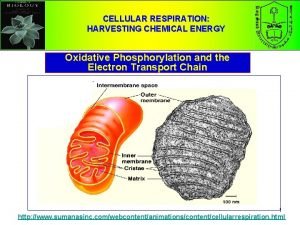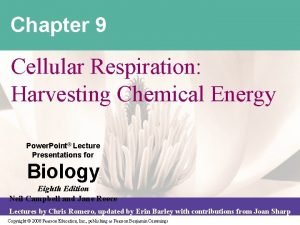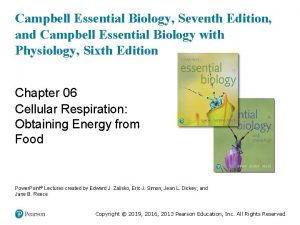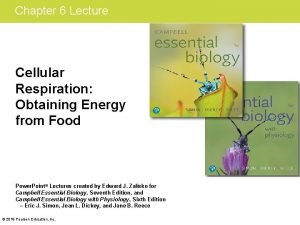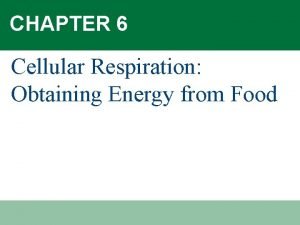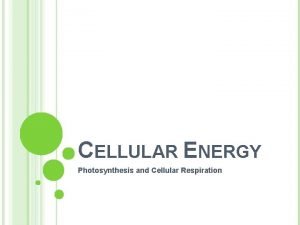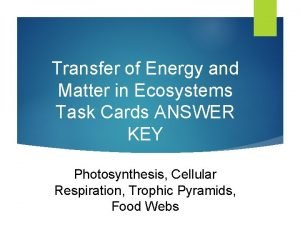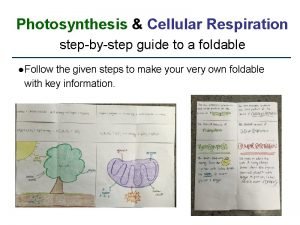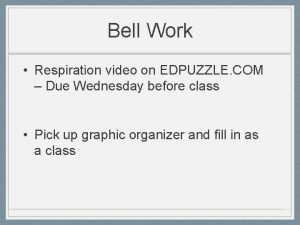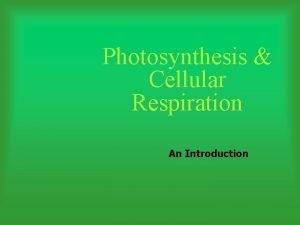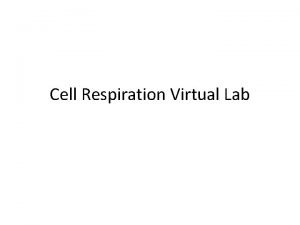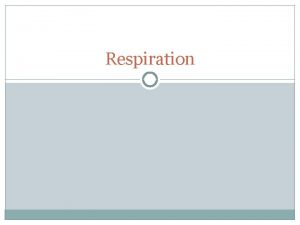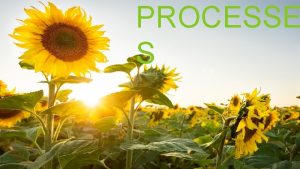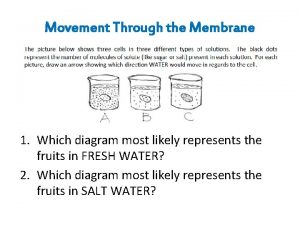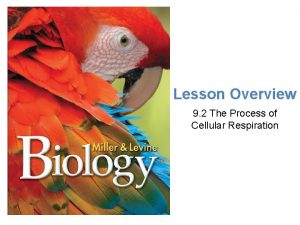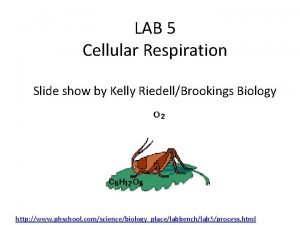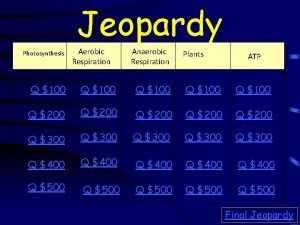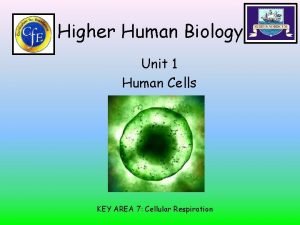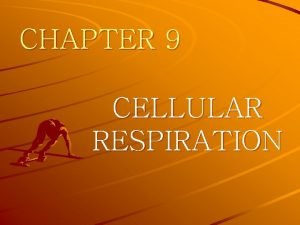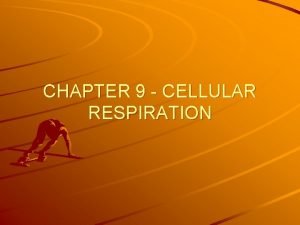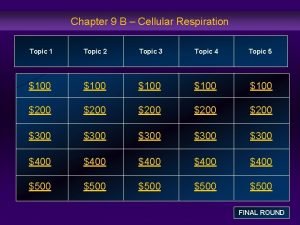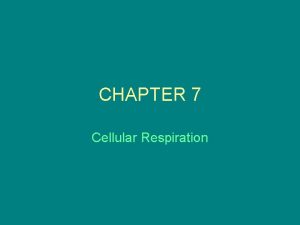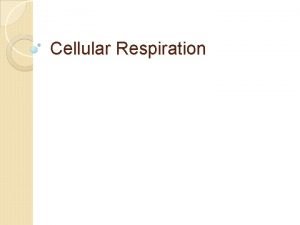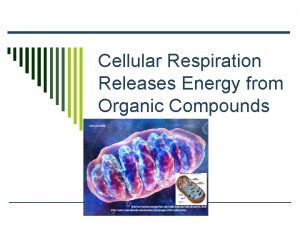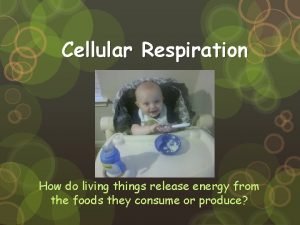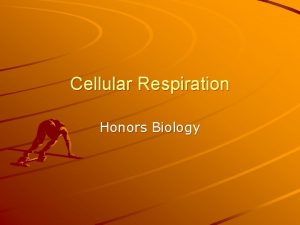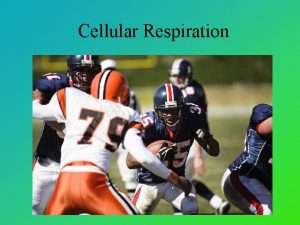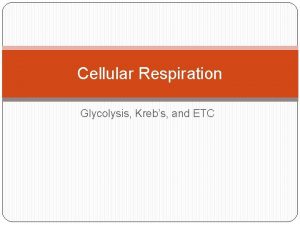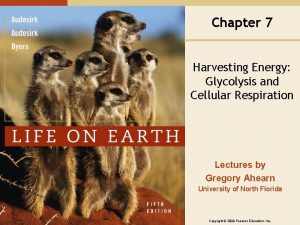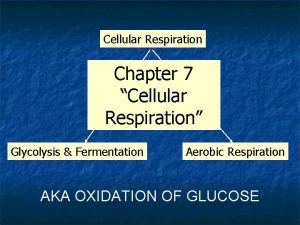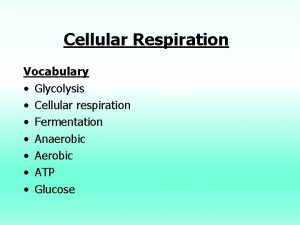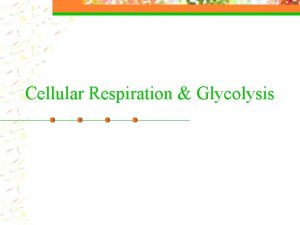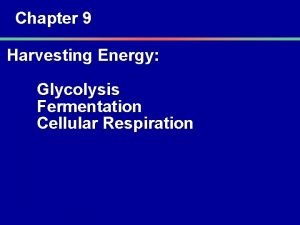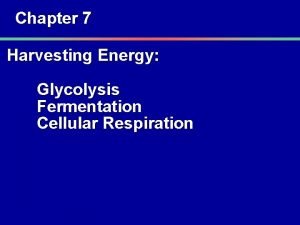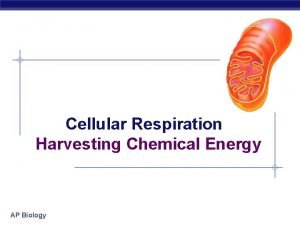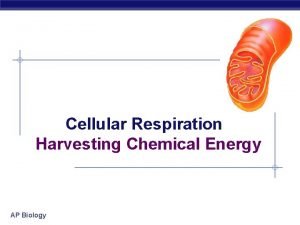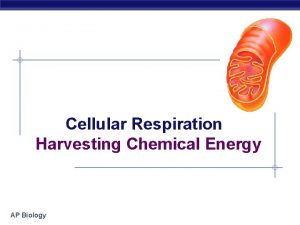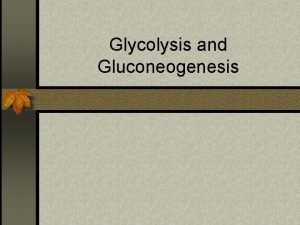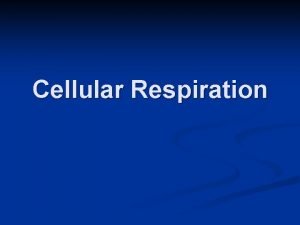Harvesting Energy Glycolysis and Cellular Respiration W O













































- Slides: 45

Harvesting Energy Glycolysis and Cellular Respiration

W O R K • Why do we humans eat food? What do we need it for, and get out of it? T O G E T H E R

Cellular respiration is an: 1. Endergonic process 2. Exergonic process 3. Exergonic OR endergonic process, depending on the organism.

In which organelle does cellular respiration occur? 1. Chloroplast 2. Mitochondria 3. Depends on whether it’s a plant or an animal.

What is “food” (i. e. source of metabolic energy) for plants? 1. 2. 3. 4. 5. Sunlight Sugar Water Oxygen Minerals

Which organisms have mitochondria? 1. Plants only 2. Animals only 3. All Eukaryotic organisms

Energy from Glucose • Glycolysis and Cellular Respiration break glucose and other carbon compounds apart. • Energy released from broken bonds is harnessed to make ATP to run cell processes. • ALL Eukaryotic organisms (including plants) carry out cellular respiration ALL THE TIME.

Cellular respiration takes place in the mitochondria. outer membrane mitochondrion intermembrane space inner membrane cristae matrix

Remember ATP? Adenosine triphosphate, the universal energy carrier, is a single nucleotide (adenine) with two extra phosphate groups attached. ATP is produced in great quantities by mitochondria.

Review: ATP is produced and used in coupled reactions glucose exergonic (glucose breakdown) protein endergonic (ATP synthesis) exergonic (ATP breakdown) CO 2 + H 2 O + heat ADP + heat net exergonic “downhill” reaction endergonic (protein synthesis) amino acids

Energy released by the exergonic breakdown of glucose is used for: 1. The endergonic production of ATP. 2. The exergonic production of ATP. 3. The endergonic breakdown of ATP. 4. The exergonic breakdown of ATP.

Which of these is true about plants and ATP? 1. Plants make and store ATP all day to use at night when the sun isn’t available. 2. Plants carry out cellular respiration day and night to supply their cells with ATP. 3. Plants use sunlight for energy instead of ATP.

Overview glucose (cytosol) 2 NADH glycolysis 2 ATP 2 pyruvate Glycolysis splits sugar into two 3 carbon chains (pyruvate), producing 2 ATPs 2 NADH (mitochondrion) 2 acetyl Co. A 6 NADH Krebs (citric acid) cycle 2 ATP 2 FADH 2 electron transport chain Cellular respiration breaks the sugar down further, producing 32 -34 ATPs. 32 or 34 ATPs Total 36 or 38 ATPs NADH and FADH (derived from vitamins B 3 and B 2) act as electron carriers.

in cytosol– no oxygen required glucose glycolysis 2 ATP if no O 2 available pyruvate fermentation ethanol + CO 2 or lactic acid in mitochondria– oxygen required CO 2 cellular respiration O 2 H 2 O 34 or 36 ATP

Which process produces the most ATP? 1. Glycolysis 2. Fermentation 3. Cellular respiration

Glycolysis in cytosol 2 ATP 2 ADP 4 ATP 2 glucose fructose bisphosphate 1 Glucose activation Glucose is split in half. 2 ATPs are used. 2 pyruvate G 3 P 2 NAD+ 2 NADH 2 Energy harvest Net gain of 2 ATPs End product is pyruvate

Glycolysis Animation Role of B Vitamins

Main points of glycolysis • 6 -carbon sugar is split into 3 -carbon pyruvate. • 2 molecules of ATP are required for glycolysis, while 4 are produced, for a net gain of 2 ATPs. • Glycolysis supplies some energy, its product (pyruvate) can be broken down further.

The products of glycolysis are: 1. ATP, NADH, pyruvate. 2. ATP, NADH, G 3 P. 3. ATP, NADH, Acetyl Co. A. 4. ATP, pyruvate, CO 2.

Where does glycolysis take place? 1. On the cristae of the mitochondria. 2. In the stroma of the mitochondria. 3. In the cell’s cytosol outside of the mitochondria.

What is the purpose of glycolysis? 1. Produces sugar. 2. Splits sugar and releases some energy. 3. Binds sugar together into polymers. 4. Uses up excess oxygen.

Cellular respiration begins with moving the products of glycolysis into the mitochondrion. 1 Formation of acetyl Co. A coenzyme A 3 NADH 3 NAD+ CO 2 NAD+ FADH 2 coenzyme A Co. A acetyl Co. A pyruvate FAD 2 Krebs cycle NADH In cytosol 2 ADP ATP In mitochondrion CO 2

Krebs Cycle Animation

The purpose of the Krebs cycle is: 1. Produces sugar. 2. Takes up excess carbon dioxide. 3. Breaks pyruvate apart, produces energy carriers. 4. Uses up excess oxygen.

The products of the Krebs cycle are: 1. 2. 3. 4. ATP and NADPH NADH, FADH 2, ATP CO 2 and O 2 Pyruvate and Acetyl Co. A

Electron carriers from the Krebs cycle are used to power an electron transport chain and proton pump. High-energy electron carriers from acetyl Co. A formation, Krebs cycle, and glycolysis feed into the ETC. FADH 2 NADH Oxygen is required to accept energydepleted electrons. 1/2 O 2 2 e– FAD NAD 2 H+ Flow of H+ down concentration gradient powers ATP synthesis. H 2 O ADP + Pi ATP matrix inner membrane Energy from high-energy electrons powers active transport of H+ by ETC. intermembrane space High H+ concentration is generated by active transport. H+ channel is coupled to ATP synthesizing enzyme.

Electron Transport Chain Animation

Main points of cellular respiration • Cellular respiration takes place in the mitochondria. • The product of glycolysis is broken down completely, releasing CO 2 as a waste gas. • The electron transport chain/proton pump complex uses energized electrons to produce up to 36 ATPs from each molecule of glucose.

The purpose of the Electron Transport Chain is: 1. Take in and fix atmospheric carbon dioxide. 2. Make sugars. 3. Produce ATP. 4. Use up excess hydrogen ions.

Which of these happens during the electron transport chain? 1. Carbon dioxide is taken up. 2. Carbon dioxide is given off. 3. Oxygen is taken up. 4. Oxygen is given off.

Oxygen taken up during the ETC eventually becomes part of: 1. 2. 3. 4. Carbon dioxide. Water. ATP. Sugar.

Mitochondria animation on XVIVO

• We breathe in to supply oxygen to pick up electrons at the end of the electron transport chain. What happens to cellular respiration if we exercise hard and our muscles are using up oxygen faster than we can supply it? W O R K T O G E T H E R

glucose (cytosol) 2 NADH 2 ATP glycolysis In the absence of oxygen, ethanol + CO cellular respiration cannot continue. Pyruvate from glycolysis is fermented, producing lactic acid or ethanol. lactate Cellular respiration requires oxygen to pick up electrons and protons at the end of an electron transport chain 2 pyruvate fermentation (no O 2) or 2 cellular respiration 2 CO 2 2 NADH 2 acetyl Co. A Krebs (citric acid) cycle 6 NADH 2 FADH 2 4 CO 2 2 ATP H O 2 1/2 O 2 2 H+ 2 e– 32 or 34 ATPs electron transport chain (mitochondrion)

If the mitochondria can’t accept pyruvate, NADH from glycolysis accumulates, depleting NAD+. Fermentation uses excess NADH to convert pyruvate to lactic acid or ethanol. regeneration NAD+ NADH 2 (glycolysis) glucose 2 ADP 2 NADH NAD+ 2 (fermentation) pyruvate lactate ATP

True or false: Fermentation is more energy efficient than cellular respiration. 1. True 2. False

What is so important about the conversion of pyruvate to lactic acid during fermentation? 1. A large amount of ATP is produced. 2. NAD+ is regenerated to keep glycolysis going. 3. Lactic acid can substitute for pyruvate to keep cellular respiration going.

• Is oxygen debt a problem in plant cells? Consider: • A leaf cell • A root cell W O R K T O G E T H E R

W O R K • Can other molecules besides sugar supply energy? Name some molecules that you think are good sources of energy. T O G E T H E R

Other monomers can be broken down for energy as well. (cytosol) fats complex carbohydrates glycerol glucose proteins amino acids Glycolysis fatty acids pyruvate Fatty acids have more energy per gram than sugars, so are preferred as energy storage. acetyl Co. A While brain cells usually must have glucose, other cells can use fatty acids and amino acids for energy. Krebs cycle electron carriers Electron transport chain (mitochondrion) synthesis breakdown Amino acids must be stripped of nitrogen first, which is disposed of in the kidneys.

What if you take in more monomers than you need to produce ATP? Simple sugars are broken apart in glycolysis. If the mitochondria does not need Acetyl Co. A, the acetate is released and can be used to synthesize fatty acids to make fats for storage.

Amino acids not needed for protein synthesis are stripped of their amine groups. The remaining carbon backbone can either be used to make Acetyl Co. A, or can be used to synthesize fatty acids.

What is one possible negative consequence of relying mainly on protein as an energy source? 1. There are no negative consequences. 2. Too much nitrogen from metabolism of amino acids can damage the kidneys. 3. Protein has fewer vitamins than other nutrients.

True or false: Fats are harder for the body to process, so you get less energy out of them and store them instead. 1. True 2. False

Recap • Cellular respiration breaks organic compounds down into inorganic compounds. • In the process, chemical energy in compounds such as sugar is converted to chemical energy in ATP. • ATP is used to run cellular processes. • ALL Eukaryotic organisms carry out cellular respiration.
 Chapter 9: cellular respiration: harvesting chemical energy
Chapter 9: cellular respiration: harvesting chemical energy Chapter 9 cellular respiration harvesting chemical energy
Chapter 9 cellular respiration harvesting chemical energy Chapter 9: cellular respiration: harvesting chemical energy
Chapter 9: cellular respiration: harvesting chemical energy Cellular respiration harvesting chemical energy
Cellular respiration harvesting chemical energy Inputs of glycolysis
Inputs of glycolysis Consumer
Consumer Cellular respiration obtaining energy from food
Cellular respiration obtaining energy from food Cellular respiration obtaining energy from food
Cellular respiration obtaining energy from food The process of photosynthesis and cellular respiration
The process of photosynthesis and cellular respiration Formula for celluar respiration
Formula for celluar respiration Equation for cell respiration
Equation for cell respiration Function of cellular respiration
Function of cellular respiration Photosynthesis and cellular respiration diagram
Photosynthesis and cellular respiration diagram Cellular respiration foldable ap biology
Cellular respiration foldable ap biology Edpuzzle photosynthesis and cellular respiration
Edpuzzle photosynthesis and cellular respiration The chemical process of photosynthesis
The chemical process of photosynthesis Cellular respiration virtual lab
Cellular respiration virtual lab The mimosa plant displays thigmotropism
The mimosa plant displays thigmotropism Photosynthesis and cellular respiration jeopardy
Photosynthesis and cellular respiration jeopardy Chapter 8 section 1 how organisms obtain energy
Chapter 8 section 1 how organisms obtain energy Redox reaction in cellular respiration
Redox reaction in cellular respiration The gray-brown haze often found over large cities is called
The gray-brown haze often found over large cities is called Cellular respiration steps
Cellular respiration steps Where is aerobic respiration located
Where is aerobic respiration located Definition of fermentation
Definition of fermentation Why is cellular respiration important
Why is cellular respiration important What plant need for photosynthesis
What plant need for photosynthesis How are internal and external respiration alike
How are internal and external respiration alike Starting materials for cellular respiration
Starting materials for cellular respiration Electron carriers in cellular respiration
Electron carriers in cellular respiration Overview of cellular respiration
Overview of cellular respiration Aerobic respiration overview
Aerobic respiration overview Cellular respiration
Cellular respiration Cellular respiration
Cellular respiration Lab bench cellular respiration
Lab bench cellular respiration What is the word equation for cellular respiration
What is the word equation for cellular respiration Higher human biology cellular respiration
Higher human biology cellular respiration Function of cellular respiration
Function of cellular respiration Cellular respiration releases
Cellular respiration releases Starting materials for cellular respiration
Starting materials for cellular respiration Chapter 8 section 3: cellular respiration
Chapter 8 section 3: cellular respiration Redox reaction in cellular respiration
Redox reaction in cellular respiration Cellular respiration formula
Cellular respiration formula Role of cellular respiration
Role of cellular respiration Cellular respiration releases
Cellular respiration releases Cellular respiration redox
Cellular respiration redox



